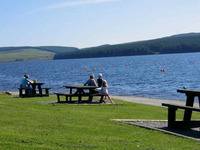Colvin and Moggridge, as landscape architects for Brenig Reservoir in North Wales [photo www.cyclingnorthwales.co.uk], reported that: 'The Planning Policy for Aled Hiraethof envisages that the moorlands, which though outside the National Park are part of the Denbigh Moors Conservation Area, should remain remote and wild' (Colvin & Moggridge 1971). To prevent the straight line of the dam crest from disrupting the wild scenery, they recommended 'a block of trees on the face of the dam above Brynï¾hir'. It was planted on a special mount so that tree roots could not penetrate, or damage, the dam structure. The following land use proposals were made to secure full integration of dam and landscape:
Over the face of the dam we recommend various land uses, to enrich its surface just as the land below is enriched. The main structure of the dam will be exposed in parts in screes of fine rocks with occasional tumbles of large rocks, which could be placed if required. Lying against this will be the toe weights, moulded gently into the land below. Where feasible agricultural land will be restored including a large pasture over the toe weight and spoil heap between Elorgarred and Brynï¾hir. In other positions vegetation of an indigenous type should be established. We consider that advice should be sought to ensure that grasses and flora suitable for such a position are sown and not an agricultural seed mixture suitable to lowland meadows (Colvin & Moggridge 1971).

